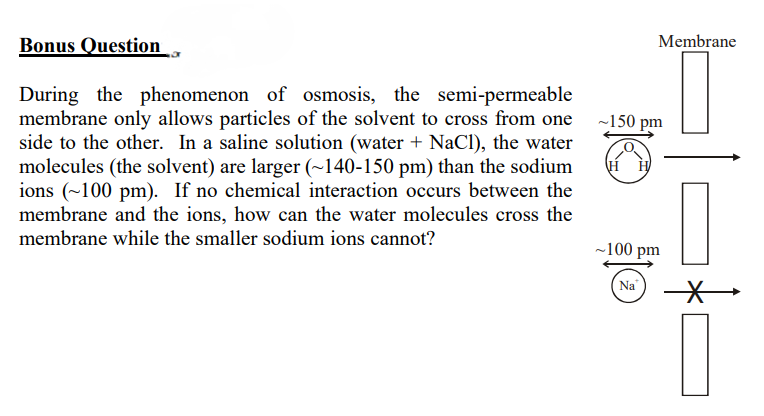Bonus Question During the phenomenon of osmosis, the semi-permeable membrane only allows particles of the solvent to cross from one side to the other. In a saline solution (water + NaCl), the water molecules (the solvent) are larger (~140-150 pm) than the sodium ions (~100 pm). If no chemical interaction occurs between the membrane and the ions, how can the water molecules cross the membrane while the smaller sodium ions cannot? -150 pm HH Membrane ~100 pm Na
Bonus Question During the phenomenon of osmosis, the semi-permeable membrane only allows particles of the solvent to cross from one side to the other. In a saline solution (water + NaCl), the water molecules (the solvent) are larger (~140-150 pm) than the sodium ions (~100 pm). If no chemical interaction occurs between the membrane and the ions, how can the water molecules cross the membrane while the smaller sodium ions cannot? -150 pm HH Membrane ~100 pm Na
Chemistry & Chemical Reactivity
10th Edition
ISBN:9781337399074
Author:John C. Kotz, Paul M. Treichel, John Townsend, David Treichel
Publisher:John C. Kotz, Paul M. Treichel, John Townsend, David Treichel
Chapter13: Solutions And Their Behavior
Section: Chapter Questions
Problem 101SCQ: You have two aqueous solutions separated by a semipermeable membrane. One contains 5.85 g of NaCl...
Related questions
Question

Transcribed Image Text:Bonus Question
During the phenomenon of osmosis, the semi-permeable
membrane only allows particles of the solvent to cross from one ~150 pm
side to the other. In a saline solution (water + NaCl), the water
molecules (the solvent) are larger (~140-150 pm) than the sodium
ions (~100 pm). If no chemical interaction occurs between the
membrane and the ions, how can the water molecules cross the
membrane while the smaller sodium ions cannot?
HH
Membrane
~100 pm
Na
*
Expert Solution
This question has been solved!
Explore an expertly crafted, step-by-step solution for a thorough understanding of key concepts.
Step by step
Solved in 2 steps

Knowledge Booster
Learn more about
Need a deep-dive on the concept behind this application? Look no further. Learn more about this topic, chemistry and related others by exploring similar questions and additional content below.Recommended textbooks for you

Chemistry & Chemical Reactivity
Chemistry
ISBN:
9781337399074
Author:
John C. Kotz, Paul M. Treichel, John Townsend, David Treichel
Publisher:
Cengage Learning

Chemistry & Chemical Reactivity
Chemistry
ISBN:
9781133949640
Author:
John C. Kotz, Paul M. Treichel, John Townsend, David Treichel
Publisher:
Cengage Learning

Chemistry: The Molecular Science
Chemistry
ISBN:
9781285199047
Author:
John W. Moore, Conrad L. Stanitski
Publisher:
Cengage Learning

Chemistry & Chemical Reactivity
Chemistry
ISBN:
9781337399074
Author:
John C. Kotz, Paul M. Treichel, John Townsend, David Treichel
Publisher:
Cengage Learning

Chemistry & Chemical Reactivity
Chemistry
ISBN:
9781133949640
Author:
John C. Kotz, Paul M. Treichel, John Townsend, David Treichel
Publisher:
Cengage Learning

Chemistry: The Molecular Science
Chemistry
ISBN:
9781285199047
Author:
John W. Moore, Conrad L. Stanitski
Publisher:
Cengage Learning


Chemistry: An Atoms First Approach
Chemistry
ISBN:
9781305079243
Author:
Steven S. Zumdahl, Susan A. Zumdahl
Publisher:
Cengage Learning

Chemistry
Chemistry
ISBN:
9781305957404
Author:
Steven S. Zumdahl, Susan A. Zumdahl, Donald J. DeCoste
Publisher:
Cengage Learning